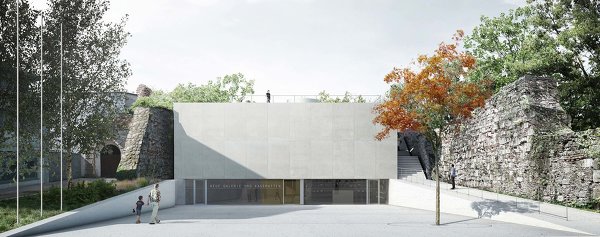Samstag, 9. März | 17:00
Neue Galerie und Kasematten, Wr. Neustadt
The project of Neue Galerie and Kasematten consists of three parts: a renovated medieval underground artillery storage space – Kasematten, Welcome Center and an exhibition space – Neue Galerie. These three entities do not act as counterpoles from different time periods, but as an extension of the same structure, where the 'old' is seen as a self-evident part of the 'new' and vice versa. The different elements are connected to each other, creating a complex network of history and present and open to the city and the park.
The project uses the existing Kasematten as a connecting structure which connects all the new programmes into a seamless whole: from the entrance plaza, via Welcome centre, all the way to the Neue Galerie exhibition space, and on into a park.
The project enables numerous future uses of the historical complex. It creates a new vital center and – together with the city fortress and the city as a whole – a place linking the history with the present and (possibly) the future.
V.J.P.
Vasa J. Perović, born 1965 in Belgrade. He graduated from Faculty of Architecture in Belgrade in 1992 and received a masters degree from Berlage Institute of Architecture, Netherlands, in 1994, under the mentorship of Elia Zenghelis and Kenneth Frampton.
In 1997, together with Matija Bevk (born in 1972, graduated in 1999) they founded Bevk Perović arhitekti in Ljubljana, Slovenia. They work, alongside with the international team of 15 young architects, on a diverse range of projects, in different European countries. Since its beginnings the studio received wide international recognition. They have been awarded numerous national and international prizes (European Union Prize for Contemporary Architecture – Mies van der Rohe Emerging Architect Award in 2007, Kunstpreis Berlin in 2006, Piranesi Award in 2005, etc.).
The work of Bevk Perović arhitekti is characterized by continuous research into programmes and possibilities of their reinterpretations in contemporary architectural practice.
In order to understand and comprehend their work, one must examine their 'dedicated choice' to follow conditions in which a building emerges. These conditions range from political and social, to environmental and material – their simple, yet complex architectural solutions strive to answer those conditions beyond bare function.

Neue Galerie und Kasematten, Wr. Neustadt, Fertigstellung 2019
Rendering: courtesy Bevk Perović arhitekti